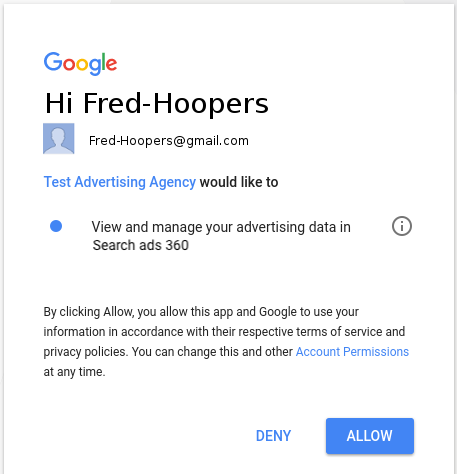Search Ads 360 API, kimlik doğrulaması için tüm isteklerde OAuth 2.0 erişim jetonu belirtilmesini zorunlu kılar. Jetonu oluşturmak ve Search Ads 360 API'ye iletmek için herhangi bir standart OAuth 2.0 kimlik doğrulama iş akışını uygulayabilirsiniz. Tamamen otomatik dönüşüm yüklemeleri ve rapor indirmeleri için uygun olduğu için aşağıda açıklanan iş akışını öneririz.
Aşağıda açıklanan iş akışının alternatifleri için Yüklü Uygulamalarda OAuth 2.0'ı Kullanma veya
Sunucudan Sunucuya Uygulamalar için OAuth 2.0'ı Kullanma'ya göz atın. Alternatif bir iş akışı kullanıyorsanız OAuth 2.0 yetkilendirme kodu istediğinizde scope parametresi olarak aşağıdaki değeri belirtin:
https://www.googleapis.com/auth/doubleclicksearch
Sunucudan sunucuya yolu izlerseniz hizmet hesabını Search Ads 360 kullanıcısı olarak ekleyin.
Önerilen yetkilendirme iş akışı
- Google API Konsolu'na gidip projenizi seçin.
Henüz bir Google API Konsolu projesi ve OAuth kimlik bilgileri oluşturmadıysanız İstemciniz için Google API Konsolu projesi ve OAuth kimlik bilgileri oluşturma başlıklı makaledeki talimatları uygulayın.
Projenizin OAuth istemci kimliğini ve sırrını bulmak için aşağıdakileri yapın:
- Kimlik bilgileri sayfasını açın.
- Ad sütununda OAuth istemcinizin adını tıklayın.
- İstemci kimliği ve gizli anahtar sayfada listelenir.
- Bir web tarayıcısı açın ve Search Ads 360'ta verilere erişme iznine sahip bir Google Hesabı ile Google'da oturum açın
.
Bu, API istemcinizi Search Ads 360 ile kimlik doğrulamak için kullanacağı Google Hesabı'dır. Google Hesabı sahibi şirketinizden ayrılırsa ve Search Ads 360 erişimini hesaptan kaldırırsanız bu yetkilendirme iş akışını tekrarlamanız ve farklı bir Google Hesabı belirtmeniz gerekir.
- Search Ads 360 yardımcı programı komut dosyasını aşağıdaki gibi çağırarak yenileme jetonu alın:
sa360Api.py --loginKomut dosyası, yenileme jetonu almak için OAuth istemci kimliğini ve gizli anahtarını kullanma sürecinde size yol gösterir. Yenileme jetonu yalnızca önceki adımda oturum açtığınız Google Hesabı için geçerlidir.
Bu işlem kapsamında komut dosyası bir URL oluşturur ve URL'yi bir web tarayıcısında ziyaret etmenizi söyler.
-
Tarayıcı, OAuth istemcisinin Search Ads 360 verilerine erişmesine izin vermenizi istediğinde, daha önce oturum açtığınız Google Hesabı'nın göründüğünden emin olun. (Birden fazla Google Hesabı'nda oturum açtıysanız farklı bir hesap gösterilebilir.)

İşlemin sonunda,
sa360Api.pykomut dosyası virgülle ayrılmış bir dize üretir. İlk değer, sağladığınız istemci kimliği, ikinci değer sağladığınız istemci gizli anahtarı ve üçüncü değer yenileme jetonudur. Aşağıdaki örnek çıkışta, yenileme jetonu kalın metinle yazılmıştır:
123456789123.apps.googleusercontent.com,ABCDEFGHIJKLMNOPQR_abcdef,1/HIJklM01OPQR23NOP456rst890uvw - İstemci kimliğini, istemci gizli anahtarını ve yenileme jetonunu arka uç veritabanında veya uygulamanızın erişebildiği başka bir güvenli konumda saklayın.
Search Ads 360 API'ye örnek JSON istekleri göndermek için
sa360Api.pykullanmayı planlıyorsanız virgülle ayrılmış dizenin tamamını uygun bir konumda tutun. Komut dosyasını her çağırdığınızda dizenin tamamını parametre olarak iletirsiniz. - Uygulamanıza aşağıdaki işlemleri yapan bir kod ekleyin:
- Yeni bir OAuth 2.0 erişim jetonu almak için istemci kimliğini, istemci gizli anahtarını ve yenileme jetonunu kullanın.
- Yeni erişim jetonunu kullanarak Search Ads 360 API'ye istek gönderin.
İstemci kitaplıklarını kullanıyorsanız bir sonraki Uygulamanızı Ayarlama bölümünde bu yetkilendirme kodunun uygulamanıza nasıl ekleneceği açıklanmaktadır.
İstemci kitaplıklarından birini kullanmıyorsanız yeni bir erişim jetonu edinmeyle ilgili öneriler için Yüklü Uygulamalar için OAuth 2.0'ı Kullanma başlıklı makaleye göz atın.

